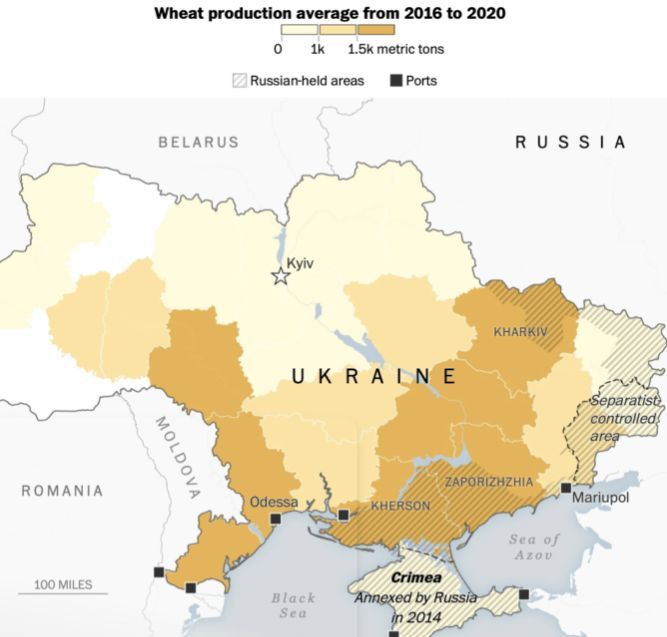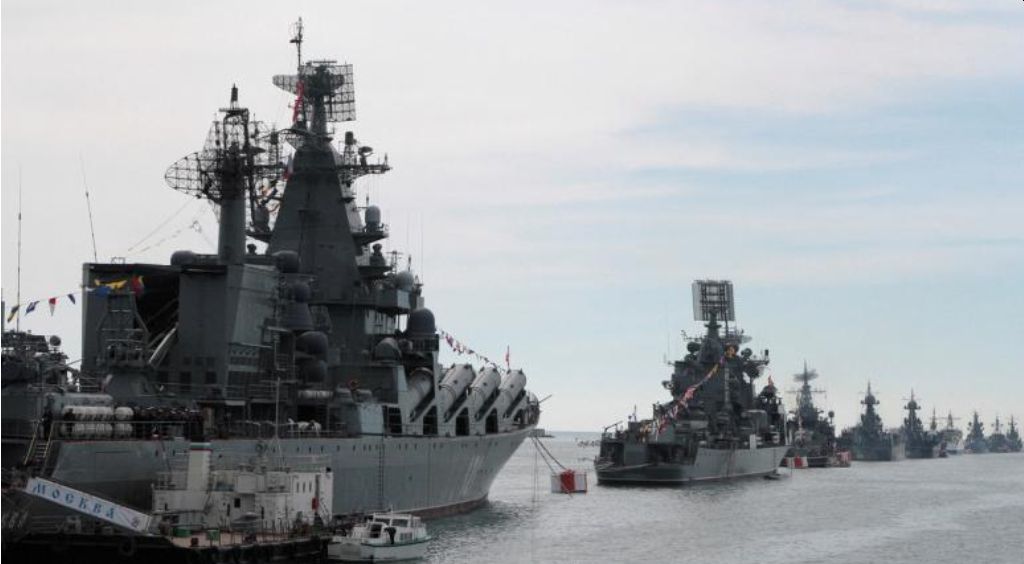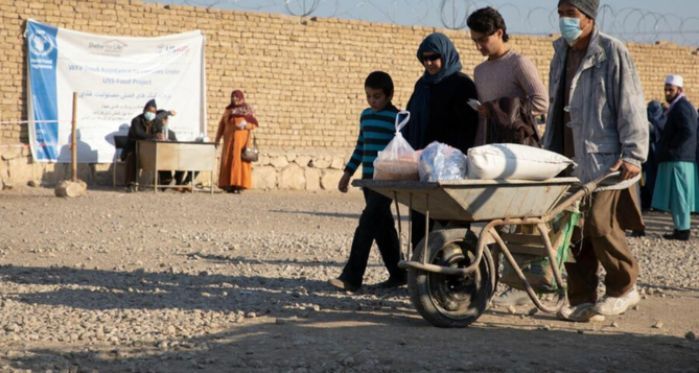By Eric Vandenbroeck and co-workers
The war about food supplies
The World Food Programme (WFP) calls for
the immediate reopening of Black Sea ports – including Odesa – so that critical
food from Ukraine can reach people facing food insecurity in countries
like Afghanistan, Ethiopia, South Sudan, Syria, and Yemen, where millions are
on the brink.
“Right now, Ukraine’s grain silos are full. At the same time, 44
million people worldwide are marching towards starvation,” said David Beasley,
Executive Director of the World Food Programme.
The UN’s food and agricultural price index reached about
160 points in March before falling 1.2 or 0.8% in April.
Cereal and meat price indices hit record highs in March. Wheat was trading in
Chicago at US$674c per bushel. Today it fetches US1,242c per bushel.
UN secretary-general António Guterres said shortages of grain and
fertilizer caused by the war, warming temperatures, and pandemic-driven supply
problems threaten to “tip tens of millions of people over the edge into food
insecurity,” as financial markets saw share prices fall heavily again on fears of
inflation and a worldwide recession.
US Secretary of State Antony Blinken has accused Russia of weaponizing
food and holding grain for millions of people
around the world hostage to help “break the spirit of the Ukrainian
people.”
“As a result of the Russian government’s actions, some 20 million tonnes of grain sit unused in Ukrainian silos as global
food supplies dwindle, prices skyrocket, causing more around the world to
experience food insecurity,” Blinken said.

Accordingly, by invading ukraine, Vladimir
Putin will destroy the lives of people far from the battlefield and on a scale
that even he may regret. The war is battering a
global food system weakened by covid-19, climate change, and an energy shock. Ukraine’s exports of
grain and oilseeds have mostly stopped, and Russia’s are threatened. Together,
the two countries supply 12% of traded calories. Wheat prices, up 53% since the
start of the year, jumped a further 6% on 16 May, after India said it would
suspend exports because of an alarming heatwave.
The widely accepted idea of a cost-of-living
crisis does not begin to capture the gravity of what may lie ahead.
António Guterres, the un secretary-general, warned on 18 May that the
coming months threaten “the specter of a global food shortage” that could last
for years. The high cost of staple foods has already raised the number of
people who cannot be sure of getting enough to eat by 440m, to 1.6bn. Nearly
250m are on the brink of famine. If, as is likely, the war drags
on, and
supplies from Russia and Ukraine are limited, hundreds of millions more people
could fall into poverty. Political unrest will spread, children will be
stunted, and people will starve.
Russia and
Ukraine supply 28% of globally traded wheat, 29% of the barley, 15% of
the maize, and 75% of the sunflower oil. Russia and Ukraine contribute about
half the cereals imported by Lebanon and Tunisia; for Libya and Egypt, the
figure is two-thirds. Ukraine’s food exports provide the calories to feed 400m
people. The war is disrupting these supplies because Ukraine has mined its
waters to deter an assault, and Russia is blockading the port of Odesa.
The Russian navy has
established a blockade of Ukraine's Black Sea Coast:

Before the invasion, the World Food Programme
warned that 2022 would be a terrible year. China, the largest wheat producer,
has said that this crop may be its worst ever after rains delayed planting last
year. In addition to India’s extreme temperatures, the world’s second-largest
producer, a lack of rain threatens to sap yields in other breadbaskets, from America’s
wheat belt to the Beauce region of France. The Horn
of Africa is being ravaged by its worst drought in four decades. Welcome to the
era of climate change.
All this will have an unfortunate effect on the poor. Households in
emerging economies spend 25% of their budgets on food, and in sub-Saharan
Africa, 40%. Bread provides 30% of all calories. Many importing
countries cannot afford subsidies to increase the help to the poor.
Afghanistan: A family
collects their rations at a food distribution point

The crisis threatens to get worse. Ukraine had already shipped much of
last summer’s crop before the war. Russia is still managing to sell its grain,
despite added costs and risks for shippers. However, those Ukrainian silos
undamaged by the fighting are full of corn and barley. Farmers have nowhere to
store their next harvest due to starting in late June, which may rot. And they
lack the fuel and labor to plant the one after that. Russia, for its part, may
lack some supplies of the seeds and pesticides it usually buys from the
European Union.
Despite soaring grain prices, farmers elsewhere may not make up the
shortfall. One reason is that prices are volatile. Worse, profit margins are
shrinking because of the surging prices of fertilizer and energy. These are
farmers’ main costs, and both markets are disrupted by sanctions and the
scramble for natural gas. If farmers cut back on fertilizer, global yields will
be lower at just the wrong time.
"Russia has launched a grain war, stoking a global food
crisis," Berlin's
top diplomat said. "It is doing so at a time when millions are already
being threatened by hunger, particularly in the Middle East and Africa."
The UN says around 20
million tonnes of grain are currently stuck in
Ukraine:

The response from worried politicians could make a bad situation worse.
Since the war started, 23 countries have declared severe restrictions on food
exports that cover 10% of globally traded calories. If trade stops, famine will
ensue.
The scene is set for a blame game, in which the West condemns Putin for
invading, and Russia decries Western sanctions. The disruptions are due to
Putin’s invasion, and some sanctions have exacerbated them.
Instead, states need to act together, starting by keeping markets open.
This week Indonesia, the source of 60% of the world’s palm oil, lifted a
temporary ban on exports. Europe should help Ukraine ship its grain via rail
and road to ports in Romania or the Baltics, though the most optimistic
forecasts say that just 20% of the harvest could get out that way. Importing
countries need support, too, so enormous bills do not capsize them. Emergency
supplies of grain should go only to the very poorest. For others, import
financing on favorable terms, perhaps provided through the imf, would allow donors’ dollars to go further. Debt relief
may also help to free up vital resources.
There is scope for substitution. About 10% of all grains are used to
make biofuel, and 18% of vegetable oils go to biodiesel. Finland and Croatia
have weakened mandates that require petrol to include fuel from crops. Others
should follow their lead. An enormous amount of grain is used to feed animals.
According to the Food and Agriculture Organisation,
grain accounts for 13% of cattle dry feed. In 2021 China imported 28m tonnes of corn to feed its pigs, more than Ukraine exports
in a year.
Working on making a change
Immediate relief would come from breaking the Black Sea
blockade. Roughly 25m tonnes of corn and wheat,
equivalent to the annual consumption of all of the world’s least developed
economies, is trapped in Ukraine. Three countries must be brought onside:
Russia needs to allow Ukrainian shipping; Ukraine has to de-mine the approach
to Odesa, and Turkey needs to let naval escorts through the Bosporus.
That will not be easy. Russia, struggling on the battlefield, is trying
to strangle Ukraine’s economy. Ukraine is reluctant to clear its mines.
Persuading them to relent will be a task for countries, including India and
China, that have sat out the war. Convoys may require armed escorts endorsed by
a broad coalition. Feeding a fragile world is everyone’s business.
The White House is working to put advanced anti-ship missiles in the
hands of Ukrainian fighters to help defeat Russia’s naval blockade, officials
said, amid concerns, that more powerful weapons that could sink Russian
warships would intensify the conflict.

But several issues are keeping Ukraine from receiving the missiles. For
one, there is limited availability of platforms to launch Harpoons from shore
-- a technically challenging solution according to several officials -- as it
is primarily a sea-based missile.
Two US officials said the United States was working on potential
solutions to pull a launcher off a US ship. According to experts and industry
executives, both missiles cost about $1.5 million per round.
Bryan Clark, a naval expert at the Hudson Institute, said 12 to 24
anti-ship missiles like the Harpoon with ranges over 100 km would be enough to
threaten Russian ships and could convince Moscow to lift the blockade. “If
Putin persists, Ukraine could take out the largest Russian ships since
they have nowhere to hide in the Black Sea,” Clark said.
Serhii Dvornyk, a member of Ukraine’s mission to the UN, backed
Blinken’s claim and called on Russia to stop “stealing” Ukrainian grain and
unblock the ports, noting that 400 million people around the world depended on
grain from Ukraine. The country’s grain exports fell from 5m tons a month
before Russia’s February invasion to 200,000 tons in March and about 1.1m tons
in April, he added.
Today also, the
European Commission published a
decision to gather
monthly data on levels of stocks in the EU of cereals, oilseeds, and rice. This
is a direct follow-up of the Communication
on “safeguarding food security and reinforcing the resilience of food systems” presented on 23 March. The aim is to better
monitor stock levels in the current environment of high prices and perceived
uncertainty about supplies.
For updates click hompage here